This article is the part of the series related to mastering DP-500/DP-600 certification exam: Designing and Implementing Enterprise-Scale Analytics Solutions Using Microsoft Azure and Microsoft Power BI and Implementing Analytics Solutions Using Microsoft Fabric
Table of contents
In the previous article, while explaining the Composite models feature, we laid a solid ground for another extremely important and powerful concept – Aggregations! It’s because in many scenarios, especially with enterprise-scale models, aggregations are a natural “ingredient” of the composite model.
However, as composite models feature can be also leveraged without aggregations involved, I thought that it would make sense to separate these two concepts in separate articles.
Before we explain how aggregations work in Power BI and take a look at some specific use cases, let’s first answer the following questions:
Why do we need aggregations in the first place? What is the benefit of having two tables with identical data in the model?
Before we come to clarify these two points, it’s important to keep in mind that there are two different types of aggregations in Power BI.
- User-defined aggregations were up until a year ago the only aggregation type in Power BI. Here, you are in charge of defining and managing aggregations, even though Power BI later automatically identifies aggregations when executing the query.
- Automatic aggregations are one of the newer features in Power BI. With the automatic aggregations feature enabled, you can grab a coffee, sit and relax, as machine learning algorithms will collect the data about the most frequently running queries in your reports and automatically build aggregations to support those queries.
The important distinction between these two types, of course besides the fact that with Automatic aggregations you don’t need to do anything except to turn this feature on in your tenant, is licensing limitations. While User-defined aggregations will work with both Premium and Pro, automatic aggregations at this moment require a Premium license.
From now on, we will talk about user-defined aggregations only, just keep that in mind.
Ok, here is a short explanation of aggregations and the way they work in Power BI. Here is the scenario: you have a large, very large fact table, which may contain hundreds of millions, or even billions of rows. So, how do you handle analytical requests over such a huge amount of data?
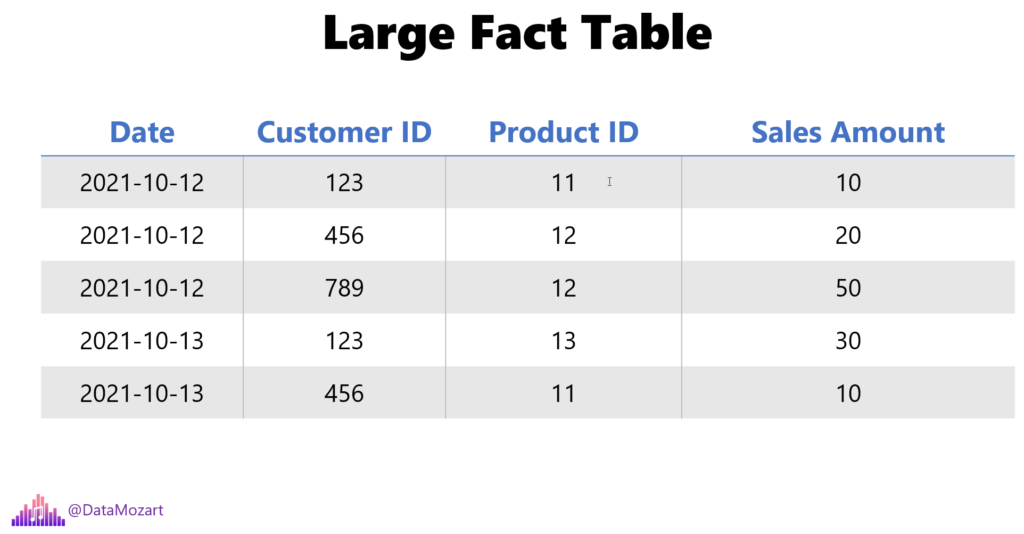
You simply create aggregated tables! In reality, it is a very rare situation, or let’s say it’s more of an exception than a rule, that the analytic requirement is to see the individual transaction, or individual record as the lowest level of detail. In most scenarios, you want to perform analysis over summarized data: like, how much revenue we had on a specific day? Or, what was the total sales amount for product X? Further, how much did customer X spent in total?
Additionally, you can aggregate the data over multiple attributes, which is usually the case, and summarize the figures for a specific date, customer, and product.

If you’re wondering what’s the point in aggregating the data…Well, the final goal is to reduce the number of rows and consequentially, reduce the overall data model size, by preparing the data in advance.
So, if I need to see the total sales amount spent by customer X on product Y in the first quarter of the year, I can take advantage of having this data already summarized in advance.
Key “Ingredient” – Make Power BI “aware” of the aggregations!
Ok, that’s one side of the story. Now comes the more interesting part. Creating aggregations per-se is not enough to speed up your Power BI reports – you need to make Power BI aware of aggregations!
Just one remark before we proceed further: aggregation awareness is something that will work only, and only if the original fact table uses DirectQuery storage mode. We’ll come soon to explain how to design and manage aggregations and how to set the proper storage mode of your tables. At this moment, just keep in mind that the original fact table should be in DirectQuery mode.
Let’s start building our aggregations!
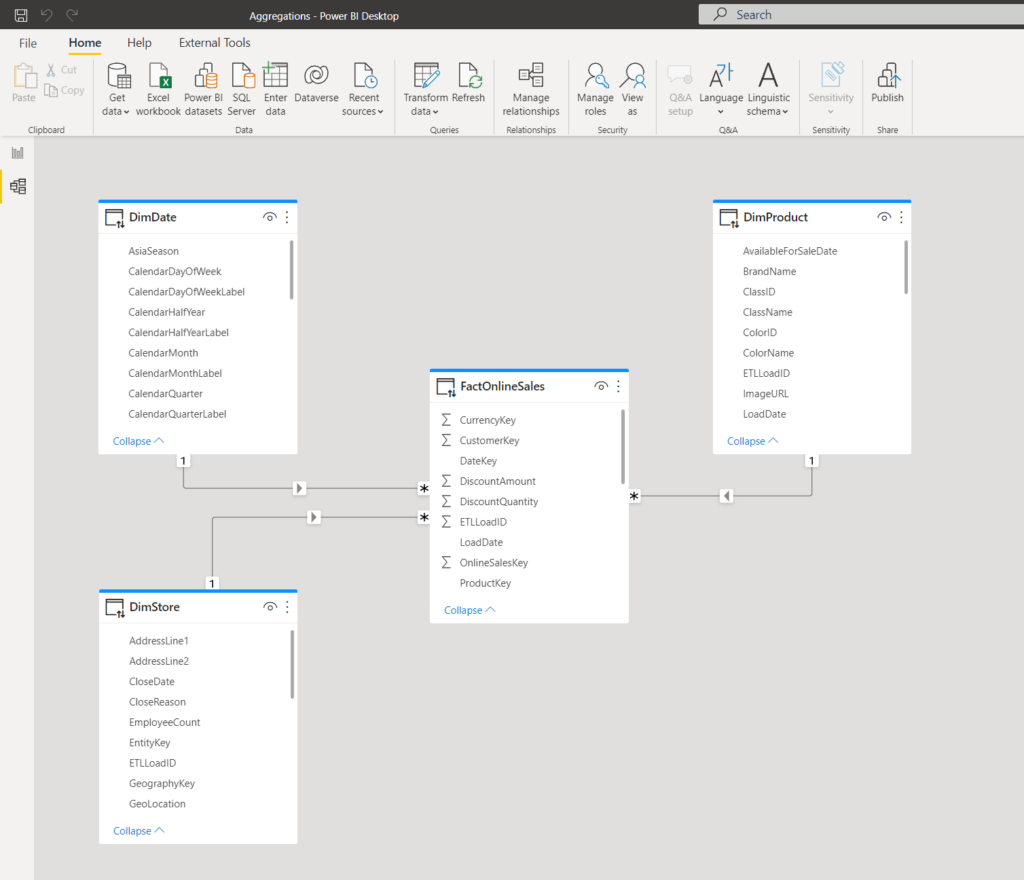
As you may see in the illustration above, our model is fairly simple – consisting of one fact table (FactOnlineSales) and three dimensions (DimDate, DimStore, and DimProduct). All tables are currently using DirectQuery storage mode.
Let’s go and create two additional tables that we will use as aggregated tables: the first one will group the data on date and product, while the other will use date and store for grouping:
/*Table 1: Agg Data per Date & Product */
SELECT DateKey
,ProductKey
,SUM(SalesAmount) AS SalesAmount
,SUM(SalesQuantity) AS SalesQuantity
FROM FactOnlineSales
GROUP BY DateKey
,ProductKey
/*Table 2: Agg Data per Date & Store */
SELECT DateKey
,StoreKey
,SUM(SalesAmount) AS SalesAmount
,SUM(SalesQuantity) AS SalesQuantity
FROM FactOnlineSales
GROUP BY DateKey
,StoreKey

I’ve renamed these queries to Sales Product Agg and Sales Store Agg respectively and closed the Power Query editor.
As we want to get the best possible performance for the majority of our queries (these queries that retrieve the data summarized by date and/or product/store), I’ll switch the storage mode of the newly created aggregated tables from DirectQuery to Import:
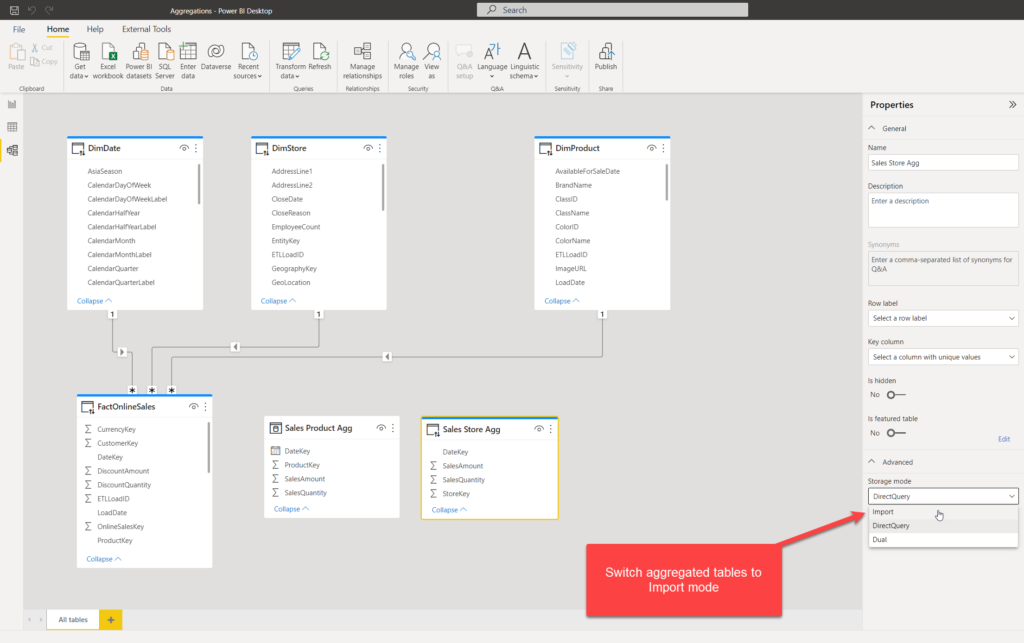
Now, these tables are loaded into cache memory, but they are still not connected to our existing dimension tables. Let’s create relationships between dimensions and aggregated tables:
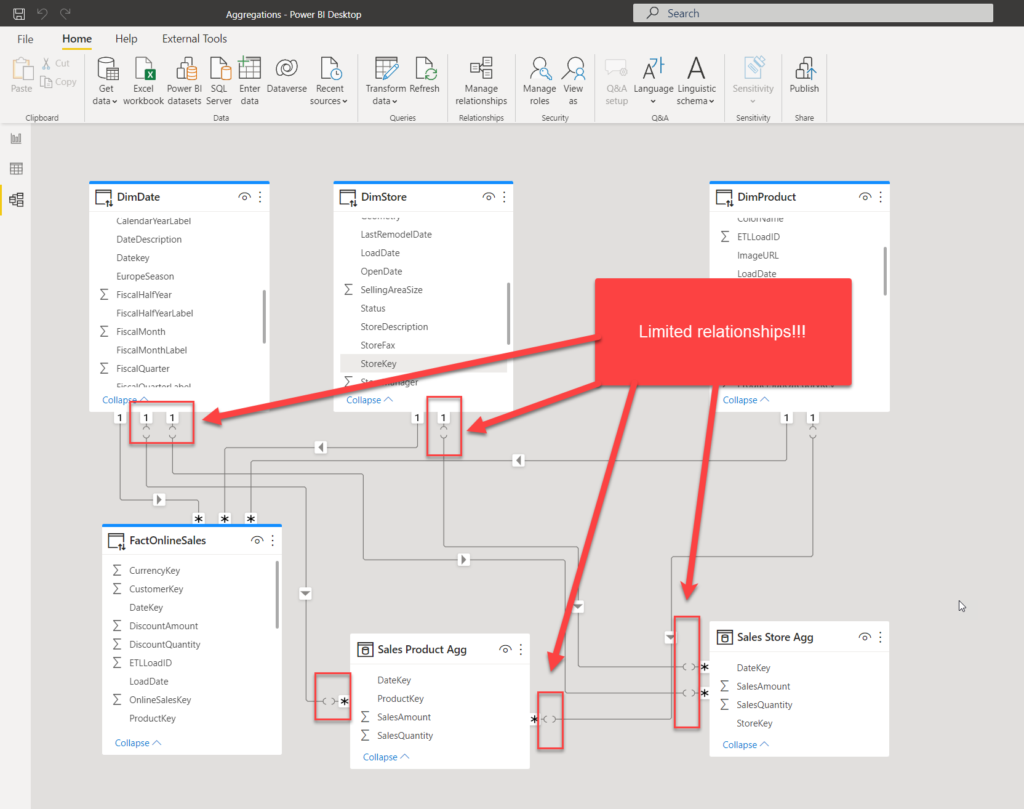
Before we proceed, let me stop for a moment and explain what happened when we created relationships. If you recall our previous article, I’ve mentioned that there are two types of relationships in Power BI: regular and limited. This is important: whenever there is a relationship between the tables from different source groups (Import mode is one source group, DirectQuery is another), you will have a limited relationship! With all its limitations and constraints.
But, I have good news for you! If I switch the storage mode of my dimension tables to Dual, that means that they’ll be also loaded into cache memory, and depending on which fact table provides the data at the query time, dimension table will behave either as Import mode (if the query targets Import mode fact tables), or DirectQuery (if the query retrieves the data from the original fact table in DirectQuery):
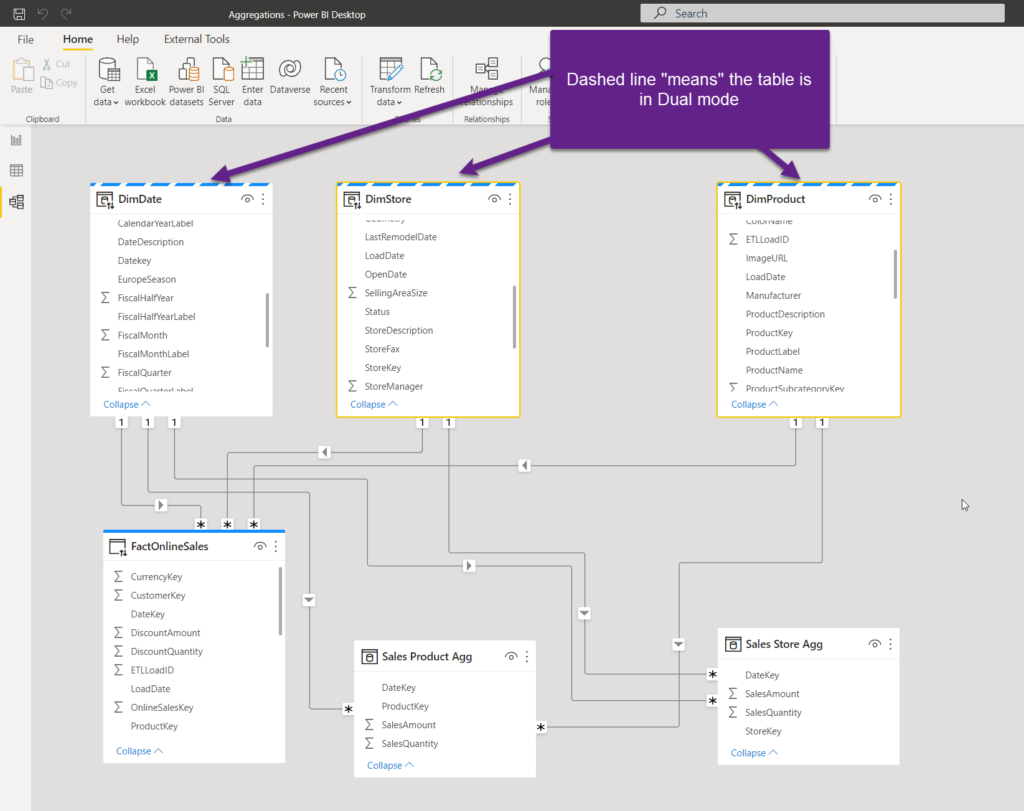
As you may notice, there are no more limited relationships, which is fantastic!
So, to wrap up, our model is configured as follows:
- The original FactOnlineSales table (with all the detailed data) – DirectQuery
- Dimension tables (DimDate, DimProduct, DimStore) – Dual
- Aggregated tables (Sales Product Agg and Sales Store Agg) – Import
Awesome! Now we have our aggregated tables and queries should run faster, right? Beep! Wrong!
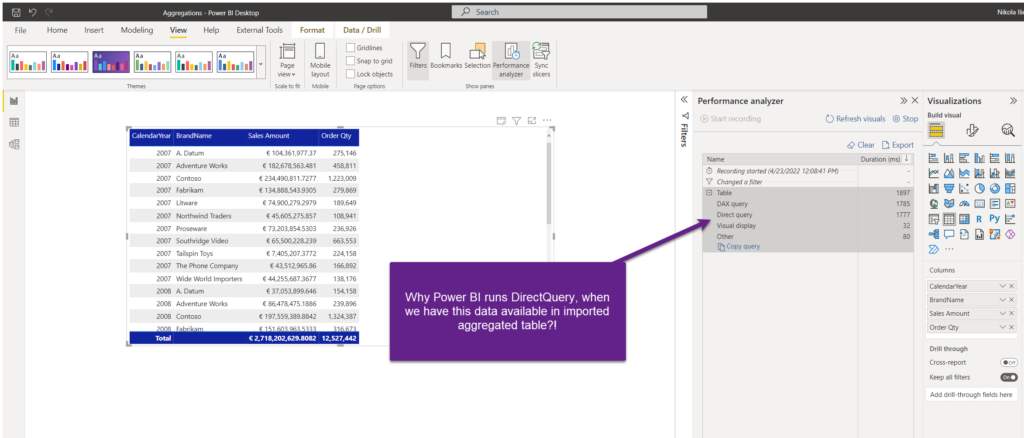
Table visual contains exactly these columns that we pre-aggregated in our Sales Product Agg table – so, why on Earth does Power BI runs a DirectQuery instead of getting the data from the imported table? That’s a fair question!
Remember when I told you in the beginning that we need to make Power BI aware of the aggregated table, so it can be used in the queries?
Let’s go back to Power BI Desktop and do this:
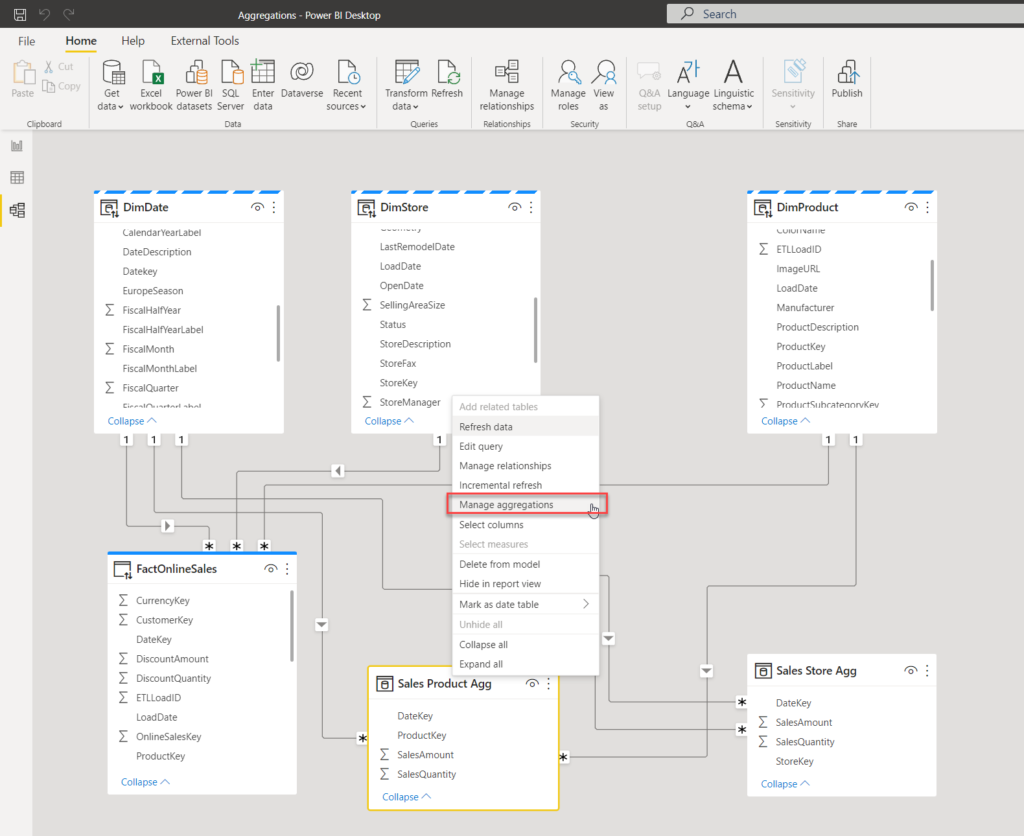
Right-click on the Sales Product Agg table and choose the Manage aggregations option:

A few important remarks here: in order for aggregations to work, data types between the columns from the original fact table and aggregated table must match! In my case, I had to change the data type of the SalesAmount column in my aggregated table from “Decimal number” to “Fixed decimal number”.
Additionally, you see the message written in red: that means, once you create an aggregated table, it will be hidden from the end-user! I’ve applied exactly the same steps for my second aggregated table (Store), and now these tables are hidden:

Let’s go back now and refresh our report page to see if something changed:
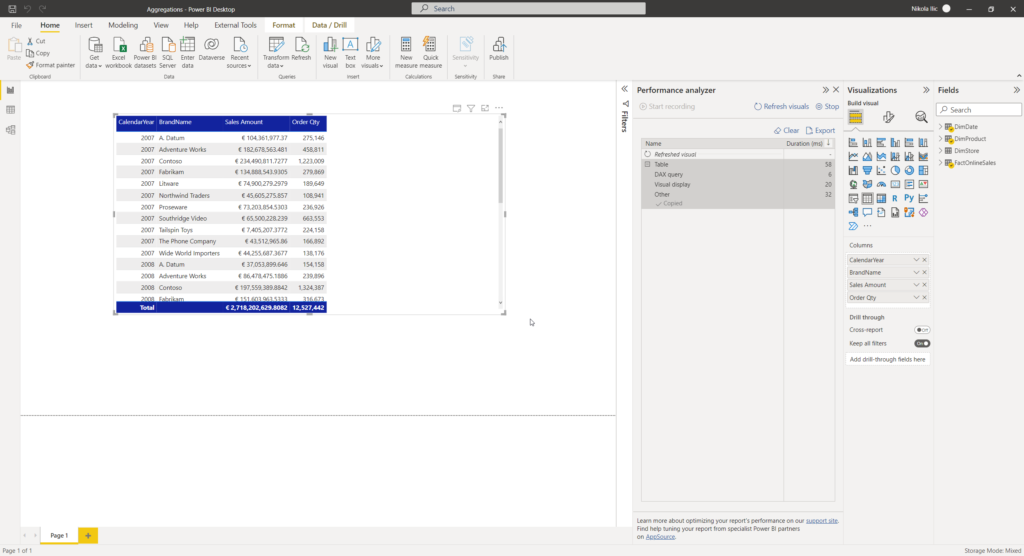
Nice! No DirectQuery this time, and instead of almost 2 seconds needed to render this visual, this time it took only 58 milliseconds! Moreover, if I grab the query and go to DAX Studio to check what’s going on…
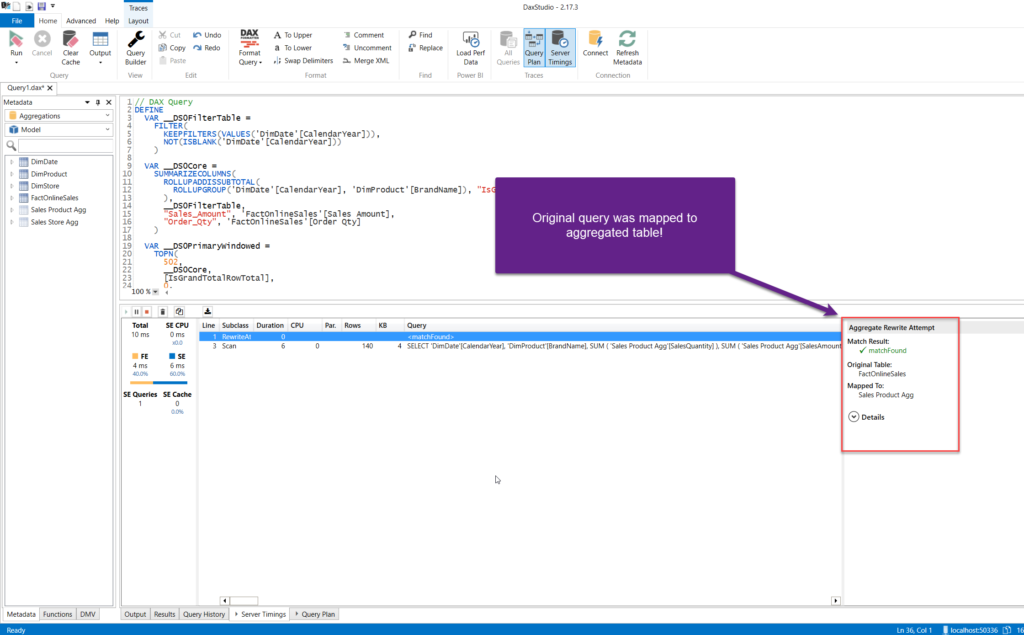
As you see, the original query was mapped to target the aggregated table from import mode, and the message “Match found” clearly says that the data for the visual came from the Sales Product Agg table! Even though our user doesn’t have a clue that this table even exists in the model!
The difference in performance, even on this relatively small dataset, is huge!
Multiple aggregated tables
Now, you’re probably wondering why I’ve created two different aggregated tables. Well, let’s say that I have a query that displays the data for various stores, also grouped by date dimension. Instead of having to scan 12.6 million rows in DirectQuery mode, the engine can easily serve the numbers from the cache, from the table that has just a few thousand rows!
Essentially, you can create multiple aggregated tables in the data model – not just combining two grouping attributes (like we had here with Date+Product or Date+Store), but including additional attributes (for example, including Date and both Product and Store in the one aggregated table). This way, you’ll increase the granularity of the table, but in case your visual needs to display the numbers both for product and store, you’ll be able to retrieve results from the cache only!
In our example, as I don’t have pre-aggregated data on the level that includes both product and store, if I include a store in the table, I’m losing the benefit of having aggregated tables:
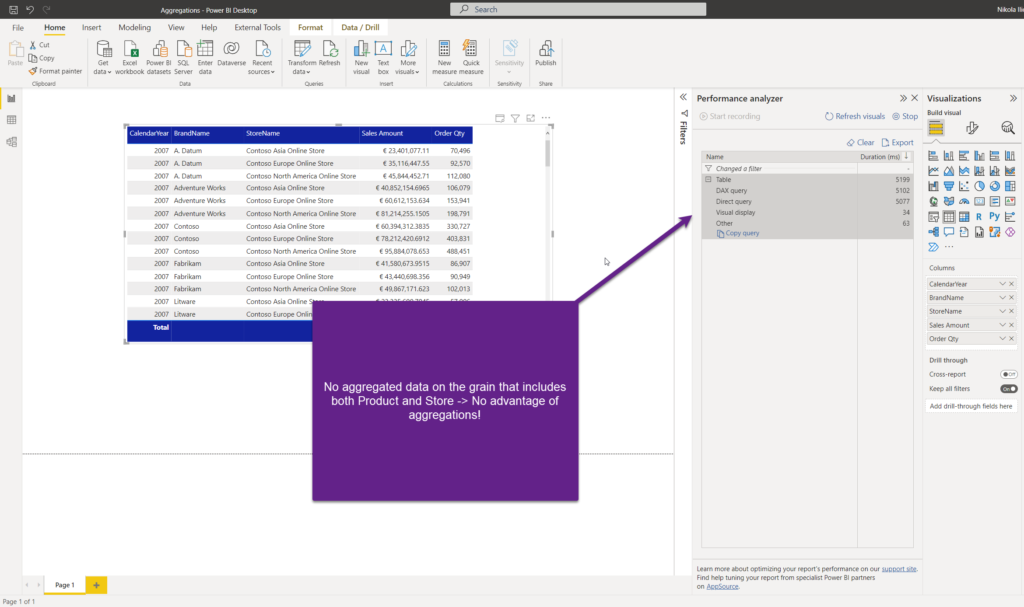
So, in order to leverage aggregations, you need to have them defined on the exact same level of grain as the visual requires!
Aggregation Precedence
There is one more important property to understand when working with aggregations – precedence! When the Manage aggregations dialog box opens, there is an option to set the aggregation precedence:
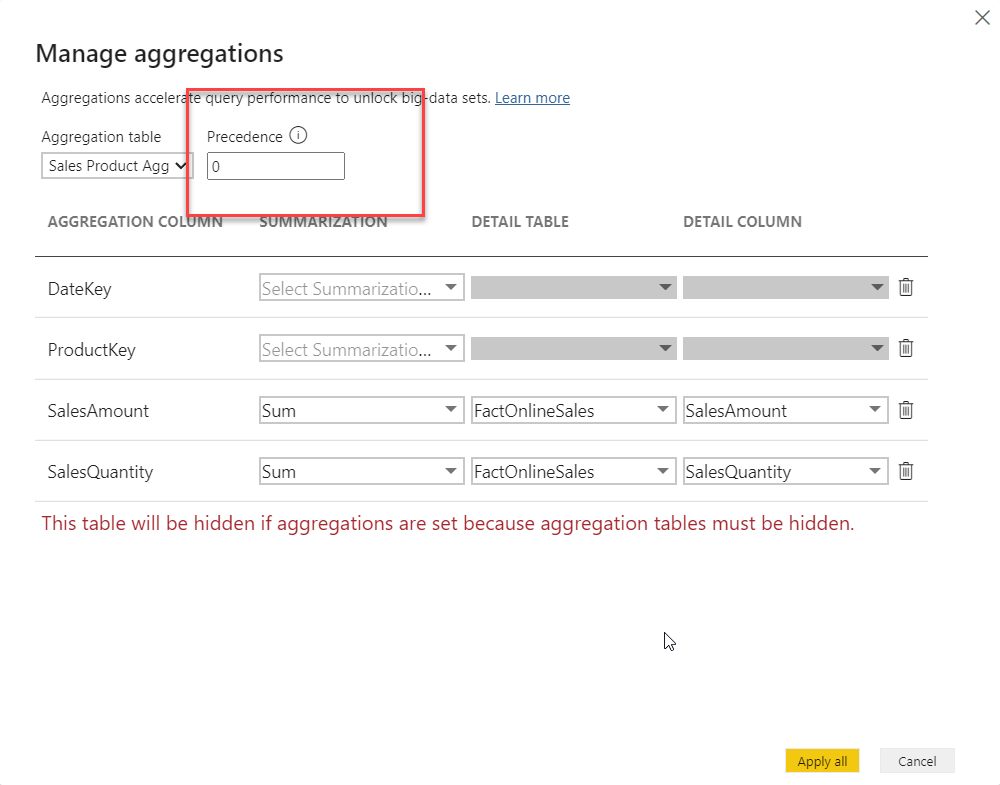
This value “instructs” Power BI on which aggregated table to use in case the query can be satisfied from multiple different aggregations! By default, it’s set to 0, but you can change the value. The higher the number, the higher the precedence of that aggregation.
Why is this important? Well, think of a scenario where you have the main fact table with billion of rows. And, you create multiple aggregated tables on different grains:
- Aggregated table 1: groups data on Date level – has ~ 2000 rows (5 years of dates)
- Aggregated table 2: groups data on Date & Product level – has ~ 100.000 rows (5 years of dates x 50 products)
- Aggregated table 3: groups data on Date, Product & Store level – has ~ 5.000.000 rows (100.000 from the previous grain x 50 stores)
Now, let’s say that the report visual displays aggregated data on the date level only. What do you think: is it better to scan Table 1 (2.000 rows) or Table 3 (5 million rows)? I believe you know the answer:) In theory, the query can be satisfied from both tables, so why rely on the arbitrary choice of Power BI?!
Instead, when you’re creating multiple aggregated tables, with different levels of granularity, make sure to set the precedence value in a way that tables with lower granularity get priority!
Conclusion
Aggregations are one of the most powerful features in Power BI, especially in scenarios with large datasets! Despite the fact that both composite models feature and aggregations can be used independently of each other, these two are usually used in synergy, to provide the most optimal balance between the performance and having all the details of the data available!
Thanks for reading!
Last Updated on December 17, 2023 by Nikola

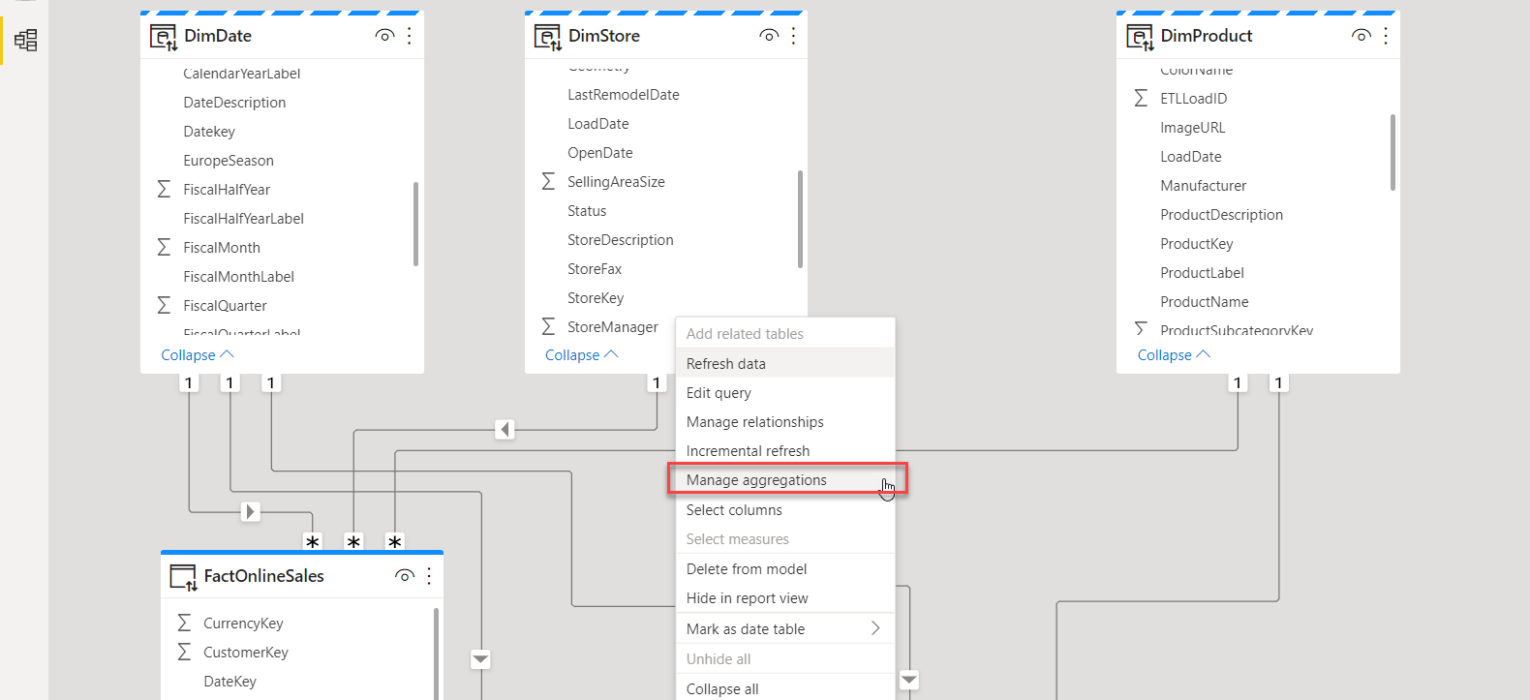

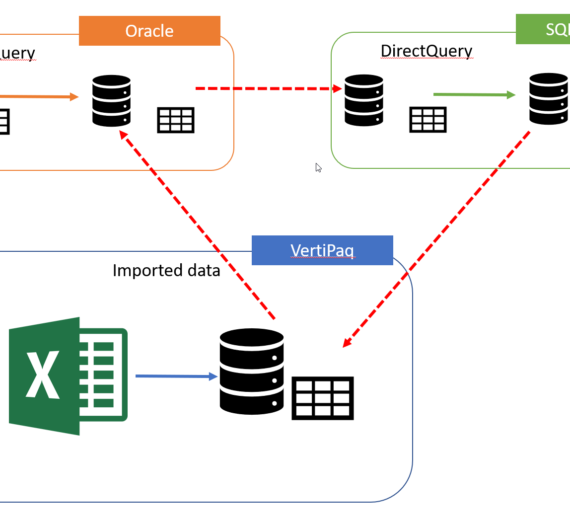

Fernando Calero
Hi Nikola,
Great article, thank you. One comment, I see you don’t include the publishing date of your blog post, do you see that better than including it?
Regards,
Fernando
Nikola
Hey Fernando,
Thanks for your feedback! Actually, the original published date is included on the main page, while I keep the “Updated date” within the article itself (at the bottom), as it sometimes happens that I apply modifications to the article.
Philip Robinson
Hi Nikola, this article (and all the others in the DP-500 series) is really helpful. Just one question if that’s ok, why is the [factonlinesales] table in direct query mode? Can you end up in a scenario where the data in [factonlinesales] table and [Sales Product Agg] don’t balance as the direct query tables have the latest data and the import tables might not have been refreshed. Thanks Phil
Nikola
Hi Phil,
Thanks! For User-defined aggregations in Power BI to work, the detailed table (which is FactOnlineSales in our example) MUST be in DirectQuery storage mode. If you want a “one table fits all” solution, then I’d recommend taking a look at the Hybrid tables feature, which combines DirectQuery and Import within one single table! I wrote about this feature here: https://data-mozart.com/hybrid-tables-in-power-bi-the-ultimate-guide/
Hope this helps:)
Philip Robinson
Cheers Nikola!
Olivier
Hi Nikola,
Thank you for your work, and all your articles. They are very clear and helpful.
My question is close to the previous one.
We always discuss Aggregation with both import and DQ tables. Is there any sens doing it with only import tables to reduce the granularity scanned on most measures but still being able to deep dive, while avoid multiple switch measure checking with table should be queried.
Nikola
Hi Olivier,
That’s a fair question. However, user-defined aggregations in Power BI work ONLY and only if the main table (fact table) is in DQ mode. Hope this helps.
Cheers,
Nikola
Joel
Hi Nikola,
I hope you are fine! I’ve started with Power Bi some month ago and this feature looks great but I have 2 Questions:
1- Are we still using “Real-Time data” from DQ mode or just one snapshot of the data? Because I see some tables in Import Mode and FactTable with Direct Query so seems to be a mixed of method that make me feel confused.
2-This is an approach to only be used with huge amount of data? I’ve always heard that Import Mode always works faster than Direct Query Mode so I’ve always tried to avoid DQ.
Nikola
Hi Joel,
1. If the data for the visual is served from the Direct Query table, then it’s “real-time”. If it’s mapped to the aggregated table (Import mode), then it’s the snapshot of the data when the aggregated table was last time refreshed
2. That’s correct. Import mode should always be a default choice, and, as you pointed out correctly, Direct Query should be used only when Import mode is not an option
Hope this helps.
Best,
Nikola
Ricky Schechter
Hi Nikola! Thank you for this great article. I was wondering if with the introduction of DirectLake mode, it feels a better choice to aggregate outside PBI, rather with queries/pySpark notes triggered manually/pipelines into “aggregated” tables in the Lakehouse and then… consume those with PBI using DirectLake… also shared with/consumed by any other with right access. I am sure that prior Fabric, aggregations (manual/automatic) provided a great value, does it still now?
Nikola
Great point Ricky!
You are absolutely spot on – with Direct Lake, some common concepts, such as aggregations and/or incremental refresh, should be performed in a different way. I still haven’t tested myself, but I’d say it make sense now to create aggregated tables as delta tables in the Lakehouse/Warehouse, instead in Power BI. Of course, for “traditional” scenario (Import aggs + DQ for the detailed table), aggregations are still a superb way to improve the performance.
Bob Kundrat
Excellent Article Nicola! All your work is very much appreciated.
My question is similar to Phil Robinsons question earlier in this thread. In short, I understand that the main fact table must be DQ in order for aggregations to work, however, what approaches do you follow to make sure that the aggregation tables aren’t out of sync with the DQ table given that the aggregated tables could be stale compared to the DQ table?
Nikola
Thanks Bob. Well, depends on the use case, but usually if there are no hard real-time requirements, scheduling refreshes multiple times per day does the job quite nice.
VS
Hello Nikola, thank you for such good article. I have one question related to precedence values which is not fully clear for me:
In the last example on this article, you created 3 aggregation tables (with records 2000, 100000, 500000). Of course, dimension tables have relations on all those 3 agg tables. When I have table visual on the report, on which I want to have aggregated data by date only, I’ll put the fields from agg table Table 1 (with 2000 records), so it will query/scan only the Table 1, and why precedence matters in this case at all?
Thank you for the answer in advance
Nikola
Hi,
No, you will not put fields from aggregated tables, they are hidden by default and can’t be used in visuals. You will keep fields from the original, detailed table, and then Power BI automatically remap your queries in the background to retrieve the data from aggregated tables. Therefore, precedence is important, because Power BI will first look for query results in the smaller table.
Hope this helps.